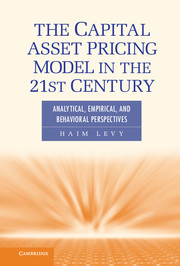 The Capital Asset Pricing Model in the 21st Century
The Capital Asset Pricing Model in the 21st Century Book contents
- Frontmatter
- Contents
- Preface
- 1 Introduction
- 2 Expected Utility Theory
- 3 Expected Utility and Investment Decision Rules
- 4 The Mean-Variance Rule (M-V Rule)
- 5 The Capital Asset Pricing Model
- 6 Extensions of the Capital Asset Pricing Model
- 7 The Capital Asset Pricing Model Cannot Be Rejected
- 8 Theoretical and Empirical Criticism of the Mean-Variance Rule
- 9 Prospect Theory and Expected Utility
- 10 Cumulative Decision Weights
- 11 The Mean-Variance Rule, the Capital Asset Pricing Model, and the Cumulative Prospect Theory
- References
- Name Index
- Subject Index
2 - Expected Utility Theory
Published online by Cambridge University Press: 05 June 2012
- Frontmatter
- Contents
- Preface
- 1 Introduction
- 2 Expected Utility Theory
- 3 Expected Utility and Investment Decision Rules
- 4 The Mean-Variance Rule (M-V Rule)
- 5 The Capital Asset Pricing Model
- 6 Extensions of the Capital Asset Pricing Model
- 7 The Capital Asset Pricing Model Cannot Be Rejected
- 8 Theoretical and Empirical Criticism of the Mean-Variance Rule
- 9 Prospect Theory and Expected Utility
- 10 Cumulative Decision Weights
- 11 The Mean-Variance Rule, the Capital Asset Pricing Model, and the Cumulative Prospect Theory
- References
- Name Index
- Subject Index
Summary
Introduction
Investors generally face many prospects available in the capital market to choose from (e.g., stocks, bonds, portfolios of assets, and mutual funds), where only one portfolio (which may contain one or many assets) of these prospects is selected. To be able to make systematic choices, one needs a method for ranking the various investments. Finding the appropriate method for ranking the various prospects is not an easy task. Moreover, many methods are available, each with its pros and cons, and researchers generally disagree on the appropriate ranking method to be employed. This chapter is devoted to the expected utility ranking method and to the existing criticisms of this method. In subsequent chapters, we show the relation of the Mean-Variance (M-V) analysis and the Capital Asset Pricing Model (CAPM) to the Expected Utility Theory (EUT), and we also show how deviations from the expected utility paradigm affect the M-V and the CAPM.
In the trivial and unrealistic situation in which certainty prevails, the prospects’ ranking is a simple task, and the optimal prospect is the one with the highest monetary outcome. Thus, when certainty prevails, there is no dispute among researchers regarding the method for ranking the various prospects under consideration. However, things become more complex and less agreeable when the outcomes of the various prospects are uncertain. Moreover, to be able to rank prospects under uncertainty, one first needs to establish a measure characterizing the profitability (and maybe the risk) of each prospect that technically enables us to rank the various prospects in an unambiguous way. Technically, this can be done, for example, by calculating the expected outcome of each prospect. By the mean outcome criterion, we have an unambiguous ranking: the prospect with the highest mean outcome should be selected. This does not mean that this ranking is optimal. For example, this ranking criterion ignores risk, which is a severe drawback. Suppose, for example, that prospect F yields $5 or $15 with equal probability; hence, the mean is $10. Prospect G yields –$10 or $40 with equal probability, and hence the mean is $15. By the expected outcome criterion, G should be selected. However, many would disagree with this choice because prospect G has the disadvantage of being exposed to losses, whereas prospect F does not.
- Type
- Chapter
- Information
- The Capital Asset Pricing Model in the 21st CenturyAnalytical, Empirical, and Behavioral Perspectives, pp. 23 - 45Publisher: Cambridge University PressPrint publication year: 2011


